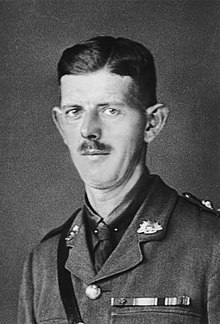Arthur Blackburn | |
|---|---|
 Captain A. S. Blackburn c. 1919 | |
| Born | 25 November 1892 Woodville, Colony of South Australia |
| Died | 24 November 1960 (aged 67) Crafers, South Australia |
| Buried | |
| Allegiance | Australia |
| Service | Australian Army |
| Years of service |
|
| Rank | Brigadier |
| Unit | 10th Battalion (1914–1916) |
| Commands |
|
| Battles / wars | |
| Awards | |
| Relations |
|
| Other work |
|
Brigadier Arthur Seaforth Blackburn, VC, CMG, CBE, ED, JP (25 November 1892 – 24 November 1960) was an Australian soldier, lawyer, politician, and recipient of the Victoria Cross (VC), the highest award for valour in battle that could be awarded to a member of the Australian armed forces at the time. A lawyer and part-time soldier prior to the outbreak of World War I, Blackburn enlisted in the Australian Imperial Force in August 1914, and was assigned to the 10th Battalion. His unit landed at Anzac Cove, Gallipoli, on April 25, 1915, and he and another scout were credited with advancing the furthest inland on the day of the landing. Blackburn was later commissioned and, along with his battalion, spent the rest of the Gallipoli campaign fighting Ottoman forces.
The 10th Battalion was withdrawn from Gallipoli in November 1915, and after re-organising and training in Egypt, sailed for the Western Front in late March 1916. It saw its first real fighting in France on 23 July during the Battle of Pozières, part of the Battle of the Somme. It was during this battle that Blackburn's actions resulted in a recommendation for his award of the VC. Commanding 50 men, he led four separate sorties to drive the Germans from a strong point using hand grenades, capturing 370 yards (340 m) of trench. He was the first member of his battalion to be awarded the VC during World War I, and the first South Australian to receive the VC. He also fought in the Battle of Mouquet Farm in August, before being evacuated to the United Kingdom and then Australia suffering from illness. He was medically discharged in early 1917.
Blackburn returned to legal practice and pursued a military career during the interwar period, and served as a member of the South Australian parliament in 1918–1921. He led the Returned Sailors' and Soldiers' Imperial League of Australia in South Australia for several years, and was appointed the coroner for the city of Adelaide, South Australia. After the outbreak of World War II, Blackburn was appointed to command the 2/3rd Machine Gun Battalion of the Second Australian Imperial Force, and led it during the Syria–Lebanon Campaign against the Vichy French in 1941, during which he personally accepted the surrender of Damascus. In early 1942, his battalion was withdrawn from the Middle East and played a role in the defence of Java in the Dutch East Indies from the Japanese. Captured, Blackburn spent the rest of the war as a prisoner-of-war. After he was liberated in 1945, he returned to Australia and was made a Commander of the Order of the British Empire (CBE) for his services on Java in 1942.
Following the war, Blackburn was appointed as a conciliation commissioner of the Commonwealth Court of Conciliation and Arbitration until 1955 and in that year was made a Companion of the Order of St Michael and St George (CMG) for his services to the community. He died in 1960 and was buried with full military honours in the Australian Imperial Force section of the West Terrace Cemetery, Adelaide. His Victoria Cross and other medals are displayed in the Hall of Valour at the Australian War Memorial.